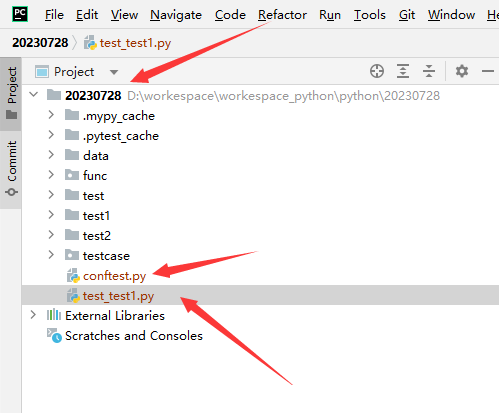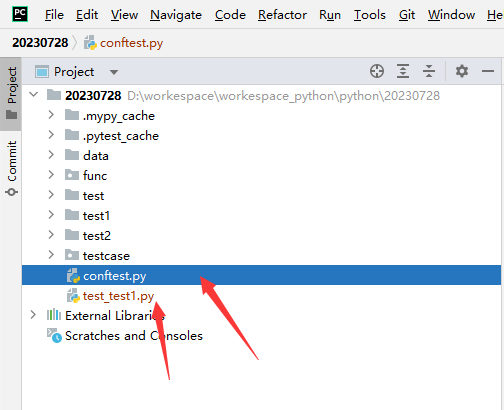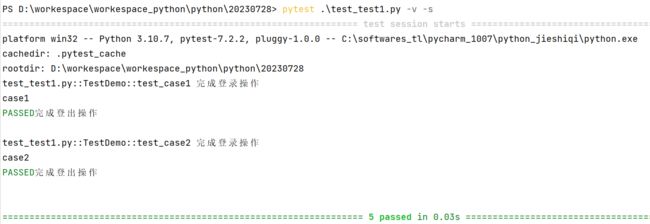Pytest测试框架3
目录:
- pytest结合数据驱动-yaml
- pytest结合数据驱动-excel
- pytest结合数据驱动-csv
- pytest结合数据驱动-json
- pytest测试用例生命周期管理(一)
- pytest测试用例生命周期管理(二)
- pytest测试用例生命周期管理(三)
- pytest测试用例生命周期管理-自动注册
- pytest测试用例生命周期管理-自动生效
- pytestfixture实现参数化
1.pytest结合数据驱动-yaml
数据驱动
-
什么是数据驱动?
- 数据驱动就是数据的改变从而驱动自动化测试的执行,最终引起测试结果的改变。简单来说,就是参数化的应用。数据量小的测试用例可以使用代码的参数化来实现数据驱动,数据量大的情况下建议大家使用一种结构化的文件(例如 yaml,json 等)来对数据进行存储,然后在测试用例中读取这些数据。
-
应用:
- App、Web、接口自动化测试
- 测试步骤的数据驱动
- 测试数据的数据驱动
- 配置的数据驱动
yaml 文件介绍
- 对象:键值对的集合,用冒号 “:” 表示
- 数组:一组按次序排列的值,前加 “-”
- 纯量:单个的、不可再分的值
- 字符串
- 布尔值
- 整数
- 浮点数
- Null
- 时间
- 日期
# 编程语言
languages:
- PHP
- Java
- Python
book:
Python入门: # 书籍名称
price: 55.5
author: Lily
available: True
repertory: 20
date: 2018-02-17
Java入门:
price: 60
author: Lily
available: False
repertory: Null
date: 2018-05-11yaml 文件使用
- 查看 yaml 文件
- pycharm
- txt 记事本
- 读取 yaml 文件
- 安装:
pip install pyyaml - 方法:
yaml.safe_load(f) - 方法:
yaml.safe_dump(f)
- 安装:
import yaml
file_path = './my.yaml'
with open(file_path, 'r', encoding='utf-8') as f:
data = yaml.safe_load(f)代码实例:
工程目录结构
- data 目录:存放 yaml 数据文件
- func 目录:存放被测函数文件
- testcase 目录:存放测试用例文件
# 工程目录结构
.
├── data
│ └── data.yaml
├── func
│ ├── __init__.py
│ └── operation.py
└── testcase
├── __init__.py
└── test_add.py测试准备
- 被测对象:
operation.py - 测试用例:
test_add.py - 测试数据:
data.yaml
# operation.py 文件内容
def my_add(x, y):
result = x + y
return result
# test_add.py 文件内容
class TestWithYAML:
@pytest.mark.parametrize('x,y,expected', [[1, 1, 2]])
def test_add(self, x, y, expected):
assert my_add(int(x), int(y)) == int(expected)
# data.yaml 文件内容
-
- 1
- 1
- 2
-
- 3
- 6
- 9
-
- 100
- 200
- 300import pytest
import yaml
from func.operation import my_add
# 方法一
# class TestWithYAML:
# @pytest.mark.parametrize('x,y,expected', [[1, 1, 2], [3, 6, 9], [100, 200, 300]])
# def test_add(self, x, y, expected):
# assert my_add(int(x), int(y)) == int(expected)
# 方法二
def get_data():
with open("../data/data.yaml", encoding='utf-8') as f:
data = yaml.safe_load(f)
return data
class TestWithYAML:
@pytest.mark.parametrize('x,y,expected', get_data())
def test_add(self, x, y, expected):
assert my_add(int(x), int(y)) == int(expected)
2.pytest结合数据驱动-excel
读取 Excel 文件
-
第三方库
xlrdxlwingspandas
-
openpyxl
- 官方文档: https://openpyxl.readthedocs.io/en/stable/
openpyxl 库的安装
- 安装:
pip install openpyxl - 导入:
import openpyxl
openpyxl 库的操作
-
读取工作簿
-
读取工作表
-
读取单元格
import openpyxl
# 获取工作簿
book = openpyxl.load_workbook('./data/test.xlsx')
# 读取工作表
sheet = book.active
print(sheet)
# 读取单个单元格
cell_a1 = sheet['A1']
print(cell_a1.value)
cell_a3 = sheet.cell(column=1, row=3) # A3
print(cell_a3.value)
# 读取多个连续单元格
cells = sheet["A1":"C3"]
for i in cells:
for j in i:
print(j.value,end=' ')
print()代码实例:
import openpyxl
import pytest
import yaml
from func.operation import my_add
# 方法一
# class TestWithYAML:
# @pytest.mark.parametrize('x,y,expected', [[1, 1, 2], [3, 6, 9], [100, 200, 300]])
# def test_add(self, x, y, expected):
# assert my_add(int(x), int(y)) == int(expected)
# 方法二
# def get_data():
# with open("../data/data.yaml", encoding='utf-8') as f:
# data = yaml.safe_load(f)
# return data
#
#
# class TestWithYAML:
# @pytest.mark.parametrize('x,y,expected', get_data())
# def test_add(self, x, y, expected):
# assert my_add(int(x), int(y)) == int(expected)
# 方法三
def get_excel():
book = openpyxl.load_workbook("../data/test.xlsx")
sheet = book.active
cells = sheet["A1":"C3"]
values = []
for row in cells:
data = []
for cell in row:
data.append(cell.value)
values.append(data)
return values
class TestWithYAML:
@pytest.mark.parametrize('x,y,expected', get_excel())
def test_add(self, x, y, expected):
assert my_add(int(x), int(y)) == int(expected)
3.pytest结合数据驱动-csv
csv 文件介绍
- csv:逗号分隔值
- 是 Comma-Separated Values 的缩写
- 以纯文本形式存储数字和文本
- 文件由任意数目的记录组成
- 每行记录由多个字段组成
Linux从入门到高级,linux,¥5000
web自动化测试进阶,python,¥3000
app自动化测试进阶,python,¥6000
Docker容器化技术,linux,¥5000
测试平台开发与实战,python,¥8000csv 文件使用
-
读取数据
- 内置函数:
open() - 内置模块:
csv
- 内置函数:
-
方法:
csv.reader(iterable)- 参数:iterable ,文件或列表对象
- 返回:迭代器,每次迭代会返回一行数据。
import csv
def get_csv():
with open('./data/params.csv', 'r', encoding='utf-8') as file:
raw = csv.reader(file)
for line in raw:
print(line)
if __name__ == '__main__':
get_csv()代码实例:
测试准备
-
被测对象:
operation.py -
测试用例:
test_add.py -
测试数据:
params.csv
# operation.py 文件内容
def my_add(x, y):
result = x + y
return result
# test_add.py 文件内容
class TestWithCSV:
@pytest.mark.parametrize('x,y,expected', [[1, 1, 2]])
def test_add(self, x, y, expected):
assert my_add(int(x), int(y)) == int(expected)
# params.csv 文件内容
1,1,2
3,6,9
100,200,300import csv
import openpyxl
import pytest
import yaml
from func.operation import my_add
# 方法一
# class TestWithYAML:
# @pytest.mark.parametrize('x,y,expected', [[1, 1, 2], [3, 6, 9], [100, 200, 300]])
# def test_add(self, x, y, expected):
# assert my_add(int(x), int(y)) == int(expected)
# 方法二
# def get_data():
# with open("../data/data.yaml", encoding='utf-8') as f:
# data = yaml.safe_load(f)
# return data
#
#
# class TestWithYAML:
# @pytest.mark.parametrize('x,y,expected', get_data())
# def test_add(self, x, y, expected):
# assert my_add(int(x), int(y)) == int(expected)
# 方法三
# def get_excel():
# book = openpyxl.load_workbook("../data/test.xlsx")
# sheet = book.active
# cells = sheet["A1":"C3"]
# values = []
# for row in cells:
# data = []
# for cell in row:
# data.append(cell.value)
# values.append(data)
# return values
#
#
# class TestWithYAML:
# @pytest.mark.parametrize('x,y,expected', get_excel())
# def test_add(self, x, y, expected):
# assert my_add(int(x), int(y)) == int(expected)
# 方法四
def get_csv():
with open('../data/test.csv', encoding='utf-8') as f:
raw = csv.reader(f)
data = []
for line in raw:
data.append(line)
return data
class TestWithYAML:
@pytest.mark.parametrize('x,y,expected', get_csv())
def test_add(self, x, y, expected):
assert my_add(int(x), int(y)) == int(expected)
4.pytest结合数据驱动-json
json 文件介绍
-
json 是 JS 对象
-
全称是 JavaScript Object Notation
-
是一种轻量级的数据交换格式
-
json 结构
- 对象
{"key": value} - 数组
[value1, value2 ...]
- 对象
{
"name:": "tom",
"detail": {
"course": "python",
"city": "北京"
},
"remark": [1000, 666, 888]
}json 文件使用
- 查看 json 文件
- pycharm
- txt 记事本
- 读取 json 文件
- 内置函数 open()
- 内置库 json
- 方法:
json.loads() - 方法:
json.dumps()
params.json
{
"case1": [1, 1, 2],
"case2": [3, 6, 9],
"case3": [100, 200, 300]
}import json
def get_json():
with open('./data/params.json', 'r') as f:
data = json.loads(f.read())
print(data)
print(type(data))
s = json.dumps(data, ensure_ascii=False)
print(s)
print(type(s))
if __name__ == '__main__':
get_json()代码示例:
测试准备
-
被测对象:
operation.py -
测试用例:
test_add.py -
测试数据:
params.json
# operation.py 文件内容
def my_add(x, y):
result = x + y
return result
# test_add.py 文件内容
class TestWithJSON:
@pytest.mark.parametrize('x,y,expected', [[1, 1, 2]])
def test_add(self, x, y, expected):
assert my_add(int(x), int(y)) == int(expected)
# params.json 文件内容
{
"case1": [1, 1, 2],
"case2": [3, 6, 9],
"case3": [100, 200, 300]
}import csv
import json
import openpyxl
import pytest
import yaml
from func.operation import my_add
# 方法一
# class TestWithYAML:
# @pytest.mark.parametrize('x,y,expected', [[1, 1, 2], [3, 6, 9], [100, 200, 300]])
# def test_add(self, x, y, expected):
# assert my_add(int(x), int(y)) == int(expected)
# 方法二
# def get_data():
# with open("../data/data.yaml", encoding='utf-8') as f:
# data = yaml.safe_load(f)
# return data
#
#
# class TestWithYAML:
# @pytest.mark.parametrize('x,y,expected', get_data())
# def test_add(self, x, y, expected):
# assert my_add(int(x), int(y)) == int(expected)
# 方法三
# def get_excel():
# book = openpyxl.load_workbook("../data/test.xlsx")
# sheet = book.active
# cells = sheet["A1":"C3"]
# values = []
# for row in cells:
# data = []
# for cell in row:
# data.append(cell.value)
# values.append(data)
# return values
#
#
# class TestWithYAML:
# @pytest.mark.parametrize('x,y,expected', get_excel())
# def test_add(self, x, y, expected):
# assert my_add(int(x), int(y)) == int(expected)
# 方法四
# def get_csv():
# with open('../data/test.csv', encoding='utf-8') as f:
# raw = csv.reader(f)
# data = []
# for line in raw:
# data.append(line)
# return data
#
#
# class TestWithYAML:
# @pytest.mark.parametrize('x,y,expected', get_csv())
# def test_add(self, x, y, expected):
# assert my_add(int(x), int(y)) == int(expected)
# 方法五
def get_json():
with open('../data/params.json', 'r') as f:
data = json.loads(f.read())
print(data)
print(type(data))
print(list(data.values()))
return list(data.values())
class TestWithYAML:
@pytest.mark.parametrize('x,y,expected', get_json())
def test_add(self, x, y, expected):
assert my_add(int(x), int(y)) == int(expected)
5.pytest测试用例生命周期管理(一)
Fixture 特点及优势
- 1、命令灵活:对于 setup,teardown,可以不起这两个名字
- 2、数据共享:在 conftest.py 配置⾥写⽅法可以实现数据共享,不需要 import 导⼊。可以跨⽂件共享
- 3、scope 的层次及神奇的 yield 组合相当于各种 setup 和 teardown
- 4、实现参数化
Fixture 在自动化中的应用- 基本用法
- 场景:
测试⽤例执⾏时,有的⽤例需要登陆才能执⾏,有些⽤例不需要登陆。
setup 和 teardown ⽆法满⾜。fixture 可以。默认 scope(范围)function
- 步骤:
- 1.导⼊ pytest
- 2.在登陆的函数上⾯加@pytest.fixture()
- 3.在要使⽤的测试⽅法中传⼊(登陆函数名称),就先登陆
- 4.不传⼊的就不登陆直接执⾏测试⽅法。
import pytest
@pytest.fixture()
def login():
print('完成登录操作')
def test_search():
print('搜索')
# def test_cart():
# login()
# print('购物车')
def test_cart(login):
print('购物车')
def test_order(login):
print('下单功能')6.pytest测试用例生命周期管理(二)
Fixture 在自动化中的应用 - 作用域
| 取值 | 范围 | 说明 |
|---|---|---|
| function | 函数级 | 每一个函数或方法都会调用 |
| class | 类级别 | 每个测试类只运行一次 |
| module | 模块级 | 每一个.py 文件调用一次 |
| package | 包级 | 每一个 python 包只调用一次(暂不支持) |
| session | 会话级 | 每次会话只需要运行一次,会话内所有方法及类,模块都共享这个方法 |
import pytest
@pytest.fixture(scope="function")
def login():
print('完成登录操作')
def test_search():
print('搜索')
# def test_cart():
# login()
# print('购物车')
def test_cart(login):
print('购物车')
def test_order(login):
print('下单功能')
class TestDemo:
def test_case1(self, login):
print("case1")
def test_case2(self, login):
print("case2")
7.pytest测试用例生命周期管理(三)
Fixture 在自动化中的应用 - yield 关键字
- 场景:
你已经可以将测试⽅法【前要执⾏的或依赖的】解决了,测试⽅法后销毁清除数据的要如何进⾏呢?
- 解决:
通过在 fixture 函数中加⼊ yield 关键字,yield 是调⽤第⼀次返回结果,第⼆次执⾏它下⾯的语句返回。
- 步骤:
在@pytest.fixture(scope=module)。在登陆的⽅法中加 yield,之后加销毁清除的步骤
import pytest
'''
@pytest.fixture
def fixture_name():
setup 操作
yield 返回值
teardown 操作
'''
@pytest.fixture(scope="function")
def login():
#setup操作
print('完成登录操作')
tocken = "abcdafafasdfds"
username = 'tom'
yield tocken,username #相当于return
#teardown操作
print('完成登出操作')
def test_search():
print('搜索')
# def test_cart():
# login()
# print('购物车')
def test_cart(login):
print('购物车')
def test_order(login):
print('下单功能')
class TestDemo:
def test_case1(self, login):
print("case1")
def test_case2(self, login):
print("case2")8.pytest测试用例生命周期管理-自动注册
Fixture 在自动化中的应用 - 数据共享
- 场景:
与其他测试⼯程师合作⼀起开发时,公共的模块要放在⼤家都访问到的地⽅。
- 解决:
使⽤ conftest.py 这个⽂件进⾏数据共享,并且他可以放在不同位置起着不同的范围共享作⽤。
-
前提:
- conftest ⽂件名是不能换的
- 放在项⽬下是全局的数据共享的地⽅
-
执⾏:
- 系统执⾏到参数 login 时先从本模块中查找是否有这个名字的变量什么的,
- 之后在 conftest.py 中找是否有。
-
步骤:
将登陆模块带@pytest.fixture 写在 conftest.py 里面
代码示例:
conftest.py
# conftest.py名字是固定的,不能改变
import pytest
@pytest.fixture(scope="function")
def login():
# setup操作
print('完成登录操作')
tocken = "abcdafafasdfds"
username = 'tom'
yield tocken, username # 相当于return
# teardown操作
print('完成登出操作')test_test1.py
import pytest
'''
@pytest.fixture
def fixture_name():
setup 操作
yield 返回值
teardown 操作
'''
def test_search():
print('搜索')
# def test_cart():
# login()
# print('购物车')
def test_cart(login):
print('购物车')
def test_order(login):
print('下单功能')
class TestDemo:
def test_case1(self, login):
print("case1")
def test_case2(self, login):
print("case2")项目结构:
9.pytest测试用例生命周期管理-自动生效
Fixture 在自动化中的应用 - 自动应用
场景:
不想原测试⽅法有任何改动,或全部都⾃动实现⾃动应⽤,
没特例,也都不需要返回值时可以选择⾃动应⽤
解决:
使⽤ fixture 中参数 autouse=True 实现
步骤:
在⽅法上⾯加 @pytest.fixture(autouse=True)
test_test1.py
import pytest
'''
@pytest.fixture
def fixture_name():
setup 操作
yield 返回值
teardown 操作
'''
def test_search():
print('搜索')
# def test_cart():
# login()
# print('购物车')
# def test_cart(login):
# print('购物车')
def test_cart():
print('购物车')
# def test_order(login):
# print('下单功能')
def test_order():
print('下单功能')
class TestDemo:
# def test_case1(self, login):
# print("case1")
def test_case1(self):
print("case1")
# def test_case2(self, login):
# print("case2")
def test_case2(self):
print("case2")conftest.py
# conftest.py名字是固定的,不能改变
import pytest
@pytest.fixture(scope="function", autouse=True)
def login():
# setup操作
print('完成登录操作')
tocken = "abcdafafasdfds"
username = 'tom'
yield tocken, username # 相当于return
# teardown操作
print('完成登出操作')运行结果:
10.pytestfixture实现参数化
Fixture 在自动化中的应用 -参数化
场景:
测试离不开数据,为了数据灵活,⼀般数据都是通过参数传的
解决:
fixture 通过固定参数 request 传递
步骤:
在 fixture 中增加@pytest.fixture(params=[1, 2, 3, ‘linda’])
在⽅法参数写 request,方法体里面使用 request.param 接收参数
# @pytest.fixture(params=['tom', 'jenny'])
# def login(request):
# print(f"用户名:{request.param}")
# return request.param
#
#
# def test_demo1(login):
# print(f'demo1 case:数据为{login}')
@pytest.fixture(params=[['tom', 'harry'], ['jenny', 'jack']])
def login(request):
print(f"用户名:{request.param}")
return request.param
def test_demo1(login):
print(f'demo1 case:数据为{login}')Fixture 的用法总结
- 模拟 setup,teardown(一个用例可以引用多个 fixture)
- yield 的用法
- 作用域( session,module, 类级别,方法级别 )
- 自动执行 (autouse 参数)
- conftest.py 用法,一般会把 fixture 写在 conftest.py 文件中(这个文件名字是固定的,不能改)
- 实现参数化


